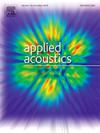Effects of synthetic and eco-friendly sound absorbers on perceived speech intelligibility ratings in a simulated open-plan office
IF 3.4
2区 物理与天体物理
Q1 ACOUSTICS
引用次数: 0
Abstract
The concept behind open-plan offices is based on promoting collaboration and dynamic interactions between workers. However, these spaces can be disruptive and noisy, with irrelevant speech ranking as one of the main elements of distraction and annoyance. To tackle the problem and reduce noise in the workplace, synthetic sound absorbers are frequently employed as one of the passive acoustic strategies. However, these materials have a significant carbon footprint since their manufacture depends on non-renewable raw materials or requires high energy consumption. Alternatively, eco-friendly sound absorbers can replace synthetic ones to improve the acoustic quality of open-plan offices. This article explores this topic, examining the impact that alternative sound absorbers have on the perceived acoustic quality of open-plan offices, compared to traditional synthetic sound absorbers. For this purpose, a real open-plan office was measured following ISO 3382-3 and the data was used to create a precise acoustic model of the room in the ODEON® software. The acoustic performance of the office with synthetic and non-traditional materials in the ceiling and screens was obtained by software simulations. To assess listeners’ perception of the acoustic quality with different sound absorbers, listening tests were conducted in which participants were exposed to auralized sounds of room acoustic simulations for each type of material. The results showed that eco-friendly sound absorbers have comparable sound attenuation to synthetic materials, and therefore the potential to be implemented in open-plan offices. Statistical analysis of the listening tests indicated that the acoustic quality of the room with eco-friendly sound absorbers is perceived in a similar way to that of synthetic sound absorbers.
求助全文
约1分钟内获得全文
求助全文
来源期刊

Applied Acoustics
物理-声学
CiteScore
7.40
自引率
11.80%
发文量
618
审稿时长
7.5 months
期刊介绍:
Since its launch in 1968, Applied Acoustics has been publishing high quality research papers providing state-of-the-art coverage of research findings for engineers and scientists involved in applications of acoustics in the widest sense.
Applied Acoustics looks not only at recent developments in the understanding of acoustics but also at ways of exploiting that understanding. The Journal aims to encourage the exchange of practical experience through publication and in so doing creates a fund of technological information that can be used for solving related problems. The presentation of information in graphical or tabular form is especially encouraged. If a report of a mathematical development is a necessary part of a paper it is important to ensure that it is there only as an integral part of a practical solution to a problem and is supported by data. Applied Acoustics encourages the exchange of practical experience in the following ways: • Complete Papers • Short Technical Notes • Review Articles; and thereby provides a wealth of technological information that can be used to solve related problems.
Manuscripts that address all fields of applications of acoustics ranging from medicine and NDT to the environment and buildings are welcome.
 求助内容:
求助内容: 应助结果提醒方式:
应助结果提醒方式:


